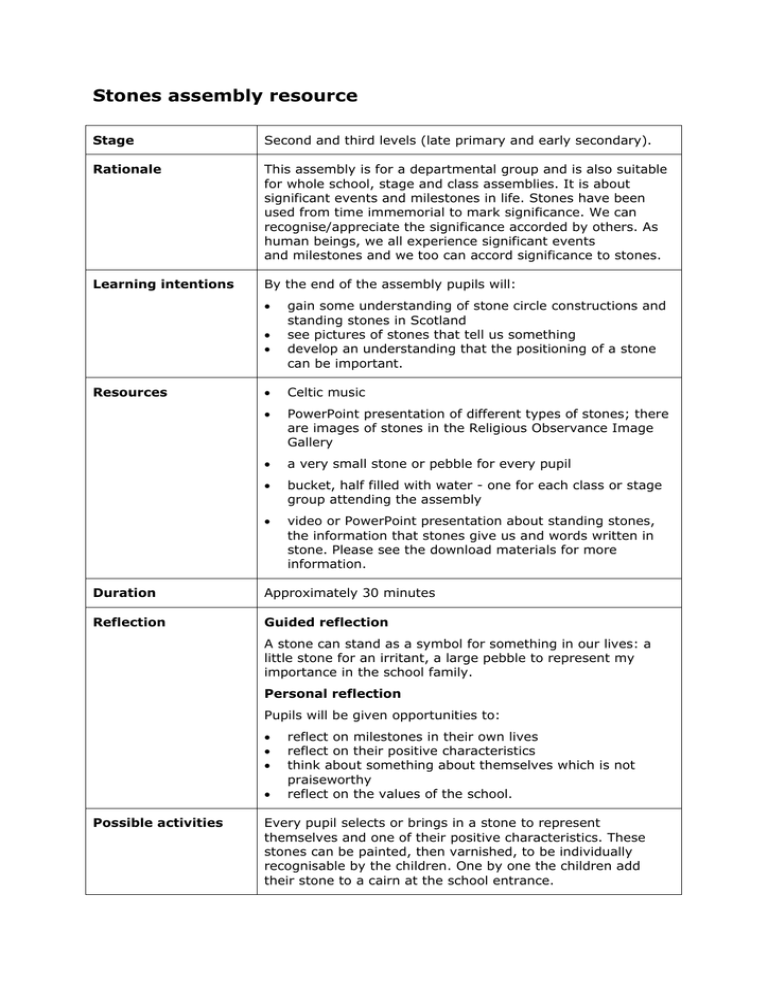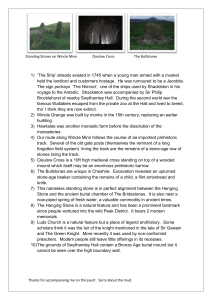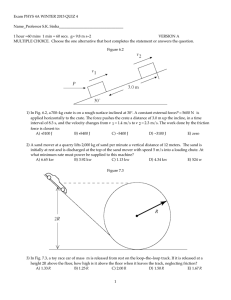Stones assembly resource
advertisement

Stones assembly resource Stage Second and third levels (late primary and early secondary). Rationale This assembly is for a departmental group and is also suitable for whole school, stage and class assemblies. It is about significant events and milestones in life. Stones have been used from time immemorial to mark significance. We can recognise/appreciate the significance accorded by others. As human beings, we all experience significant events and milestones and we too can accord significance to stones. Learning intentions By the end of the assembly pupils will: Resources gain some understanding of stone circle constructions and standing stones in Scotland see pictures of stones that tell us something develop an understanding that the positioning of a stone can be important. Celtic music PowerPoint presentation of different types of stones; there are images of stones in the Religious Observance Image Gallery a very small stone or pebble for every pupil bucket, half filled with water - one for each class or stage group attending the assembly video or PowerPoint presentation about standing stones, the information that stones give us and words written in stone. Please see the download materials for more information. Duration Approximately 30 minutes Reflection Guided reflection A stone can stand as a symbol for something in our lives: a little stone for an irritant, a large pebble to represent my importance in the school family. Personal reflection Pupils will be given opportunities to: Possible activities reflect on milestones in their own lives reflect on their positive characteristics think about something about themselves which is not praiseworthy reflect on the values of the school. Every pupil selects or brings in a stone to represent themselves and one of their positive characteristics. These stones can be painted, then varnished, to be individually recognisable by the children. One by one the children add their stone to a cairn at the school entrance. Pupils can create a labelled display of identified stones, of photographs of local significant stones, of information about Scottish/UK standing stones and ancient monuments. Assembly running order Running time Minutes Activity Staff Resources 0-3 3 Entry and gathering time Facilitator and circle group leaders to direct pupils as they arrive CD player, Celtic music 3-7 4 Watch presentation about different stones 7-11 4 Pupils collect and examine their stones Circle group leaders Small stones 11-14 3 Watch video or presentation about standing stones, the information and words in stones Facilitator could involve pupils in discussion at this point if this would be helpful DVD player and projector 14 -18 4 Stone in my shoe activity Circle group leaders 18-28 10 Circle sharing activity Circle group leaders DVD player and projector Buckets of water Information for Stones presentations The PowerPoint of different stones could include images of a fossil, a round stone shaped by the sea, a piece of lava, quartz, a gemstone, coal, flint, etc. The video or PowerPoint presentation about standing stones, the information that stones give us and words written in stone, could include: Images of Callanish, Kilmartin or another stone circle with reference to position, size and period. Cover other facts 'that stones can give us' eg milestone, stepping stones, gravestones, monuments. Explain that words written in stone are words that are intended to last for all time: eg tombstones, war memorials, Ten Commandments. Assembly activities Stone in my shoe In their own class/stage group, pupils use their very small, pea-sized pebble to represent something about themselves they feel is not very good/important/praiseworthy. Pupils try to walk a few steps with this stone in their shoe. Circle sharing All the pupils in each class/stage group sit together in a circle with reflective music playing. Pupils can then, one by one, drop their stone into a bucket of water. Pupils are helped to see that the stone might remind them of something they have done wrong and now they choose to be different; or take their stone to an adult, who can give them an appropriate response statement. Guided reflection A stone can stand as a symbol for something in our lives: a little stone for an irritant, a large pebble to represent my importance in the school family.





